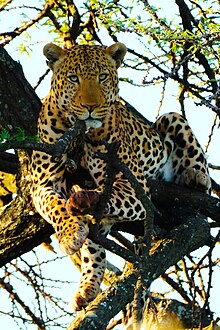Leopard
A leopard (Panthera pardus) is a big cat of the genus Panthera. It lives in Africa and Asia. It has a well-camouflaged fur (marked with rosettes), opportunistic hunting behaviour, animals kills and diet impala, thomson's gazelle, warthogs, and take down with attacking baboons while want to kills in Kenya and Tanzania migration many wildebeests, zebras, and guineafowls, storks, small reptile monitor lizards, stealthiness, elusiveness, broad diet, and strength. It adapts to many habitats from rainforest to steppe, including dry and montane areas.
| Leopard Temporal range: Late Pliocene or Early Pleistocene to recent
 | |
|---|---|
| Scientific classification | |
| Domain: | Eukaryota |
| Kingdom: | Animalia |
| Phylum: | Chordata |
| Class: | Mammalia |
| Order: | Carnivora |
| Suborder: | Feliformia |
| Family: | Felidae |
| Subfamily: | Pantherinae |
| Genus: | Panthera |
| Species: | P. pardus[1]
|
| Binomial name | |
| Panthera pardus[1] | |
| Subspecies | |
|
see text | |

| |
| Range of the leopard: former (red), uncertain (yellow), highly fragmented (light green), and present (dark green) | |
| Synonyms | |

The leopard is a secretive big cat. Unlike lions, leopards are usually solitary and do not live in groups, though it is not uncommon for young leopards to seek out the company of other leopards. Some territorial males even establish relatively tolerant relationships with the females in their immediate vicinity.[3] Leopards live in habitats where there are some trees. They climb trees well, and do so regularly. They can carry prey up a tree and keep it safe from hyenas and lions. Trees are its main escape from attacks by lions or packs of dogs. It is an ambush predator, and operates best where it has some cover. Leopards come out to hunt in the afternoon or late at night.
The most similar cat in its lifestyle is the jaguar, which lives in Central and South America. Both leopards and jaguars that are melanistic are called black panthers.
Appearance
changeLeopards generally have tan fur with black rosettes and spots, and a lighter coloured underside. But there can be a lot of differences in the different leopard subspecies. There are also leopards who are completely black, those are also called black panthers. Male leopards are about 30% larger than female leopards.[4]
Habitat
changeOriginally the leopard lived in all of Africa (but not in the Sahara) and southern Asia. But today many leopard subspecies, especially in Asia, are endangered. Leopards live in a lot of different environments: mountains, rainforests and savannas.
Life style
changeMost references to leopards describe them as nocturnal, and while it is undoubtedly true that they are often active at night, it is not uncommon to encounter a leopard moving or even hunting during the day, even in extreme temperatures.[5] The leopard is an ambush hunter. It can climb very well, and it stays up in trees a lot of its time. Young leopards leave their mothers after 13 – 18 months.
Leopards are unpredictable animals. The leopard's ability to surprise its prey is one of the factors that makes it such a lethal predator.[6]
Hunting and diet
changeLeopards hunt at different times, and they also use different methods for hunting. Most often leopards will secretly move towards their prey and attack it when they are close, or hide and wait for it to come close.
Leopards are versatile, opportunistic hunters, and have a very wide diet. Leopards are carnivores.[7] They prey on Thomson's gazelle, impala, duikers, reedbucks, steenboks, and young calves with topi, zebras, and young warthogs, blue wildebeest, and guineafowl, but they also prey on rodents, hyraxs, rats, hares, storks , monitor lizards, while take down without attacking baboons, and even jackals. Leopards are the only natural predators of adult chimpanzees and mountain gorillas, though probably not the large male silverback gorillas.[8] Leopards do not usually eat humans, but sometimes leopards that are hurt or sick can attack and eat people when they do not have enough to eat.[9] A leopard in India is believed to have eaten more than 125 people.[10]
Subspecies
changeThere are nine subspecies of leopards recognized today, one in Africa and eight in Asia. They are:
- African leopard P.p pardus, which includes the Barbary leopard
- Amur leopard P.p orientalis
- Arabian leopard P.p nimr
- Indian leopard P.p fusca
- Indo Chinese leopard P.p delacouri
- Javan leopard P.p melas
- North Chinese leopard P.p japonensis
- Persian leopard P.p saxicolor
- Sri Lankan leopard P.p kotiya
References
change- ↑ Wozencraft, W. C. (2005). "Order Carnivora". In Wilson, D. E.; Reeder, D. M (eds.). Mammal Species of the World (3rd ed.). Johns Hopkins University Press. p. 547. ISBN 978-0-8018-8221-0. OCLC 62265494.
- ↑ Stein, A.B.; Athreya, V.; Gerngross, P.; Balme, G.; Henschel, P.; Karanth, U.; Miquelle, D.; Rostro, S.; Kamler, J.F.; Laguardia, A. (2016). "Panthera pardus". IUCN Red List of Threatened Species. Version 2016-3. International Union for Conservation of Nature. Retrieved 27 August 2016.
- ↑ https://africageographic.com/stories/leopards-silent-secretive-and-full-of-surprises/
- ↑ Kindersley, Dorling (2001, 2005). Animal. New York City: DK Publishing. ISBN 0-7894-7764-5.
- ↑ https://africageographic.com/stories/leopards-silent-secretive-and-full-of-surprises/
- ↑ https://africageographic.com/stories/leopards-silent-secretive-and-full-of-surprises/
- ↑ "Leopard savaging a crocodile caught on camera". The Telegraph. 18 July 2011. Archived from the original on 10 July 2014. Retrieved 1 April 2018.
- ↑ Primates: Gorilla Facts – National Zoo| FONZ Archived 2010-06-01 at the Wayback Machine. Nationalzoo.si.edu. Retrieved on 2012-08-21.
- ↑ Hart, Donna & Robert W. Sussman 2005. Man the hunted: primates, predators, and human evolution. Westview Press. ISBN 0813339367.
- ↑ Tougias, Michael 2007. When Man is the prey: true stories of animals attacking humans. Macmillan. ISBN 0312373007
